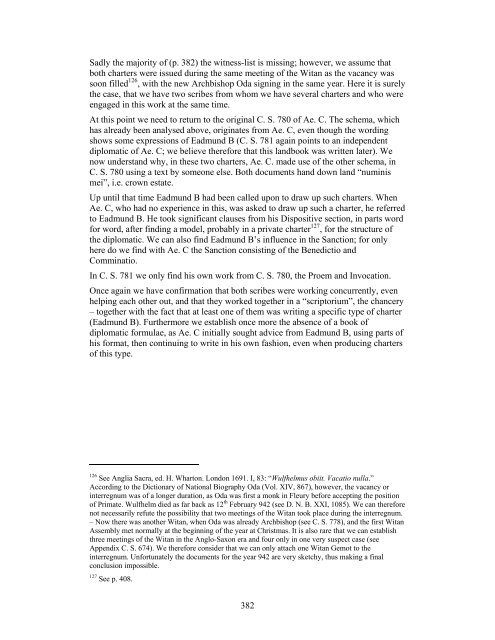Provisional Drogereit pdf
Provisional Drogereit pdf
Provisional Drogereit pdf
You also want an ePaper? Increase the reach of your titles
YUMPU automatically turns print PDFs into web optimized ePapers that Google loves.
Sadly the majority of (p. 382) the witness-list is missing; however, we assume that<br />
both charters were issued during the same meeting of the Witan as the vacancy was<br />
soon filled 126 , with the new Archbishop Oda signing in the same year. Here it is surely<br />
the case, that we have two scribes from whom we have several charters and who were<br />
engaged in this work at the same time.<br />
At this point we need to return to the original C. S. 780 of Ae. C. The schema, which<br />
has already been analysed above, originates from Ae. C, even though the wording<br />
shows some expressions of Eadmund B (C. S. 781 again points to an independent<br />
diplomatic of Ae. C; we believe therefore that this landbook was written later). We<br />
now understand why, in these two charters, Ae. C. made use of the other schema, in<br />
C. S. 780 using a text by someone else. Both documents hand down land “numinis<br />
mei”, i.e. crown estate.<br />
Up until that time Eadmund B had been called upon to draw up such charters. When<br />
Ae. C, who had no experience in this, was asked to draw up such a charter, he referred<br />
to Eadmund B. He took significant clauses from his Dispositive section, in parts word<br />
for word, after finding a model, probably in a private charter 127 , for the structure of<br />
the diplomatic. We can also find Eadmund B’s influence in the Sanction; for only<br />
here do we find with Ae. C the Sanction consisting of the Benedictio and<br />
Comminatio.<br />
In C. S. 781 we only find his own work from C. S. 780, the Proem and Invocation.<br />
Once again we have confirmation that both scribes were working concurrently, even<br />
helping each other out, and that they worked together in a “scriptorium”, the chancery<br />
– together with the fact that at least one of them was writing a specific type of charter<br />
(Eadmund B). Furthermore we establish once more the absence of a book of<br />
diplomatic formulae, as Ae. C initially sought advice from Eadmund B, using parts of<br />
his format, then continuing to write in his own fashion, even when producing charters<br />
of this type.<br />
126 See Anglia Sacra, ed. H. Wharton. London 1691. I, 83: “Wulfhelmus obiit. Vacatio nulla.”<br />
According to the Dictionary of National Biography Oda (Vol. XIV, 867), however, the vacancy or<br />
interregnum was of a longer duration, as Oda was first a monk in Fleury before accepting the position<br />
of Primate. Wulfhelm died as far back as 12 th February 942 (see D. N. B. XXI, 1085). We can therefore<br />
not necessarily refute the possibility that two meetings of the Witan took place during the interregnum.<br />
– Now there was another Witan, when Oda was already Archbishop (see C. S. 778), and the first Witan<br />
Assembly met normally at the beginning of the year at Christmas. It is also rare that we can establish<br />
three meetings of the Witan in the Anglo-Saxon era and four only in one very suspect case (see<br />
Appendix C. S. 674). We therefore consider that we can only attach one Witan Gemot to the<br />
interregnum. Unfortunately the documents for the year 942 are very sketchy, thus making a final<br />
conclusion impossible.<br />
127 See p. 408.<br />
382
















